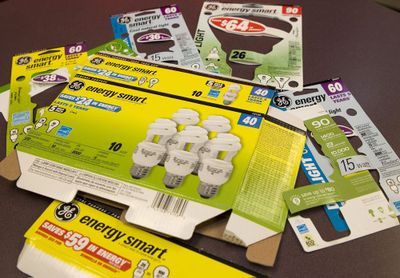Going green can leave you in the dark

You are doing The Right Thing. You are thinking globally and acting locally.
You eat what’s in season, and you buy it at the farmers market. You opt for paper at the grocery store; you recycle the bags. You compost. Maybe you even drive a hybrid.
So when the gods of the green movement thus spake, “get thee some compact fluorescent light bulbs to reduceth thine carbon footprint,” you rushed right off and replaced all of your incandescent bulbs with those twirly thingies.
And now your living room looks like a morgue. Your bedroom is screaming for a gurney instead of a four-poster.
And the kitchen? It’s fine, if you’d rather dissect the chicken than cook it.
Let’s face it: Compact fluorescent lamps, or CFLs, can turn even the most environmentally conscientious a sickly green.
“They lost my wife. She gave up on them,” says Jim Hunzinger, owner of a Brookfield, Wis., construction company that specializes in sustainable, environmentally friendly building practices.
About six weeks ago, when Joyce Hunzinger swapped out their kitchen’s dimmable incandescents with fluorescents, the light produced by the new bulbs was so ghastly and harsh, she marched them all right back to the store.
The story might have ended there were it not for Jim Hunzinger’s vow to save energy if it killed him.
“I just wouldn’t give up,” he says.
A month after his wife’s disappointing foray into fluorescent territory, Hunzinger went ahead and replaced almost 60 incandescent bulbs in and around his house with CFLs.
He managed to approximate the lighting quality he had with incandescents, but the experience left him exhausted and bleary-eyed from reading the fine print on dozens of CFL packages. He also chose not to put the bulbs in his main living spaces because the light they emitted wasn’t pleasing to him.
Hunzinger is ahead of the curve, but it’s a road we’ll all be traveling soon.
With the new Energy Independence and Security Act passed by Congress late last year, the humble incandescent light bulb as we know it today will be phased out beginning in 2012.
Before the bill passed, however, bulb makers, interior designers and other lifestyle watchers raged against the dying of the incandescent light so strenuously that lawmakers wrote in a host of exemptions, including appliance bulbs, colored bulbs, candelabra bulbs and other odd shapes.
The problem is that CFL makers are still in the dark when it comes to supplying the consumer market with lighting substitutes that mimic our cozy incandescents. And the products that are available are packaged in a confusing and unhelpful manner, for the most part, Hunzinger says.
Not all of them can be dimmed, for example. Consumers who want a dimmable CFL have to buy bulbs specifically labeled as such – and Hunzinger could only find two.
Whether or not they can be dimmed, CFLs can be dull, says Laura Ashleigh, owner and chief designer at Milwaukee’s Artistic Finishes, which specializes in unique wall treatments.
“Lighting is such an integral part of design and can play a huge role in defining the look and feel of a space,” Ashleigh says. “While incandescent and halogen tend to be on the warm side, fluorescent definitely enhances and casts a cooler, blue-green palette.”
Ashleigh has noticed that the most devoted environmentalists among her clients tend to stick with their incandescent bulbs and opt for other ways to reduce their carbon footprint.
Color is only part of the problem. Fluorescents cast a diffuse, ambient light with a narrower radial reach than incandescents. This makes them inappropriate for accent lighting or recessed canister lights that lack reflectors to direct the beam.
“What about creating mood with compact fluorescents? Well, the answer is, you can’t,” says Steven Klein, a Milwaukee lighting designer for more than 20 years.
Mood lighting requires contrast, which gives depth and texture to a room. In his work, Klein studies the impact of light and color on our lives and uses a variety of light sources to evoke a mood or establish an optimum light for a particular environment.
With a compact fluorescent, “it’s either on or it’s off,” Klein says.
Consumers need to think more about the kind of lighting they want and buy a CFL that will approximate that, says Christopher Poehlmann, a Milwaukee lamp designer who uses fluorescents in some of his designs.
“If people are saying their house looks like a dentist’s office, they are definitely not reading the labels on the CFL packages,” he says.
CFLs are rated on a scale according to how they render color: the Color Rendering Index, or CRI, which is measured against a typical incandescent.
The incandescent is 100; most CFLs have a CRI of between 80 and 85. Anything lower than that, Klein says, “it may sort of look like incandescent, but everything in the room will be pretty gray and cloudy.”
Another number to look for is the Correlated Color Temperature. The CCT, measured in Kelvin, tells you whether the light cast will be warm, cool or “emergency room surgery,” as Hunzinger puts it.
The typical incandescent is 2700 K; compact fluorescents can range from 2700 to 4100 (corporate offices) to 6500, which is known in the industry as “daylight.”
Aesthetics aside, there is also the nagging issue of CFL safety. Each bulb contains about 5 milligrams of mercury, enough to fit on the end of a ballpoint pen, which means the bulb has to be treated as hazardous waste.
Scientists debate whether these bulbs will pose as great a threat to the environment as the carbon emissions caused by incandescents.